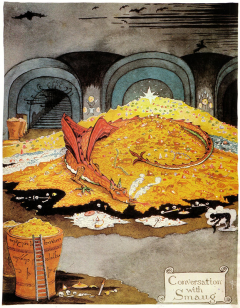Bard the Bowman is a character in J. R. R. Tolkien's The Hobbit. A Man of Laketown and a descendant of the ancient Lords of Dale, Bard manages to kill Smaug, the dragon, after which he becomes king of Dale. Tolkien created the character specifically to kill Smaug, since none of the other protagonists of the story were able to fulfill this role. Bard the Bowman could have been inspired by Wiglaf from the Anglo-Saxon poem Beowulf.
Thorin II Oakenshield, son of Thráin, son of Thrór, King under the Mountain is a fictional character in J. R. R. Tolkien's 1937 novel The Hobbit. Thorin is the leader of the Company of Dwarves who aim to reclaim the Lonely Mountain from Smaug the dragon. He is the son of Thráin II, grandson of Thrór, and becomes King of Durin's Folk during their exile from Erebor. Thorin's background is further elaborated in Appendix A of Tolkien's 1955 novel The Return of the King.

In J. R. R. Tolkien's Middle-earth legendarium, the Lonely Mountain is a mountain in the north of Wilderland. It is the source of the Celduin River, and the location of the Kingdom under the Mountain. The town of Dale lies in a vale on its southern slopes.

Esgaroth, or Lake-town, is a fictitious community of Men upon the Long Lake that appears in the 1937 novel The Hobbit by J. R. R. Tolkien. Constructed entirely of wood and standing upon wooden pillars sunk into the lake-bed, the town is south of the Lonely Mountain and east of Mirkwood. The town's prosperity is apparently built upon trade between the Men, Elves and Dwarves of northern Middle-earth. The chief mode of transport of the people of Esgaroth is their boats.
In the fiction of J. R. R. Tolkien, Rhovanion or Wilderland was a large inland region of north-west Middle-earth. It is the scene of action for much of The Hobbit and some episodes of The Lord of the Rings.
Thráin II is a fictional character in J. R. R. Tolkien's legendarium. He is first mentioned in The Hobbit and more of his history is given in Unfinished Tales.
Dáin II Ironfoot is a Dwarf and king of Erebor in J. R. R. Tolkien's high fantasy legendarium concerning Middle-earth. He appears briefly in The Hobbit and his story is elaborated in Appendix A of The Lord of the Rings.
Balin is a fictional character in J. R. R. Tolkien's legendarium. He is an important supporting character in The Hobbit, and is mentioned in The Fellowship of the Ring.
The following outline is provided as an overview of and topical guide about Tolkien's fantasy universe:
Weapons and armour of Middle-earth are found in J. R. R. Tolkien's Middle-earth fantasy writings, such as The Hobbit, The Lord of the Rings and The Silmarillion. Wars and battles are featured in much of Tolkien's writings, and weapons and armour are often given special attention.
Many of the fictional characters in J.R.R. Tolkien's legendarium are Dwarves, a short stocky race inhabiting the world of Arda. Dwarves lived in the continent Middle-earth, mostly under its mountains.

Tauriel is a fictional character from Peter Jackson's feature film adaptation of J.R.R. Tolkien's The Hobbit. The character does not appear in the original book, but was created by Peter Jackson, Philippa Boyens and Fran Walsh as an expansion of material adapted from the book, and first appears in the second and third films in that trilogy, The Hobbit: The Desolation of Smaug and The Hobbit: The Battle of the Five Armies.

The Hobbit: The Desolation of Smaug is a 2013 epic high fantasy adventure film directed by Peter Jackson and produced by WingNut Films in collaboration with New Line Cinema and Metro-Goldwyn-Mayer. It was distributed by Warner Bros. Pictures and is the second installment in the three-part film series based on the novel The Hobbit by J. R. R. Tolkien. The film was preceded by An Unexpected Journey (2012) and followed by The Battle of the Five Armies (2014); together they operate as a prequel to Jackson's The Lord of the Rings film trilogy.
The music of The Hobbit film series is composed and produced by Howard Shore, who scored all three The Lord of the Rings films, to which The Hobbit trilogy is a prequel. The score continues the style of The Lord of the Rings score, and utilizies a vast ensemble, multiple musical forms and styles, a large number of leitmotives and various unusual instruments, adding to Shore's overarching music of the Middle-earth films.

The Hobbit: The Battle of the Five Armies is a 2014 epic high fantasy directed by Peter Jackson and written by Jackson, Fran Walsh, Philippa Boyens, and Guillermo del Toro. It is the third and final installment in Peter Jackson's three-part film adaptation based on the novel The Hobbit by J. R. R. Tolkien, following An Unexpected Journey (2012) and The Desolation of Smaug (2013), and together they act as a prequel to Jackson's The Lord of the Rings film trilogy.







